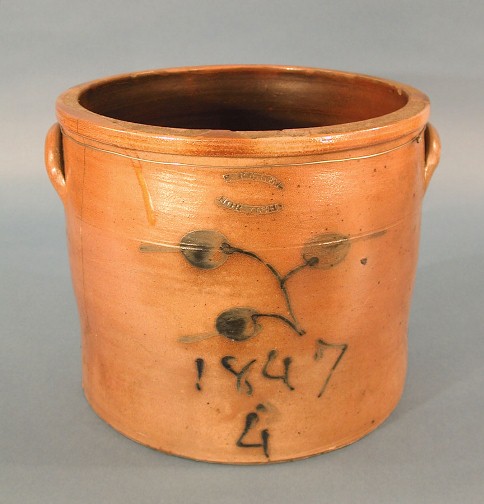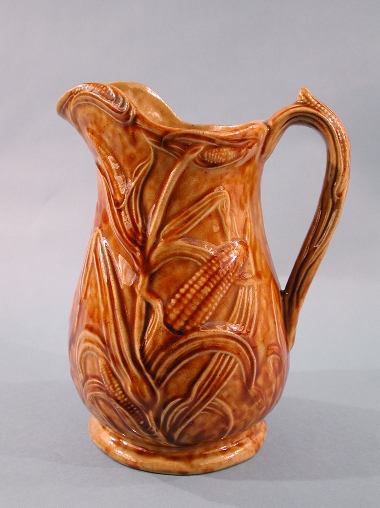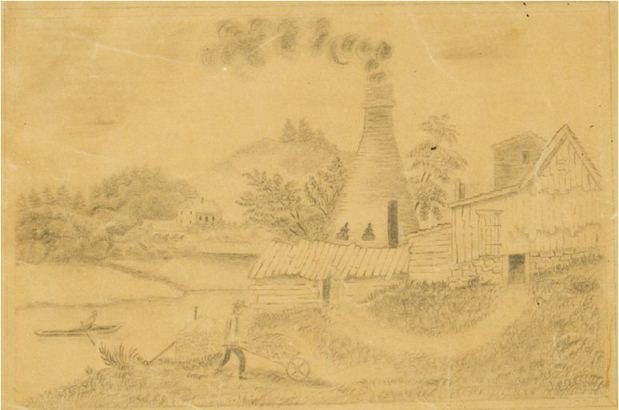By Sierra Dixon
Stoneware was the commonest form of houseware in America during the 18th and 19th centuries. Colonists started making stoneware in the early 1700s. One of Connecticut’s first potteries began making stoneware in Norwich as early as 1769.

Salt-glazed stoneware jar. Made by Armstrong & Wentworth, 1814-1834. A typical example of the utilitarian pieces produced by this firm – Connecticut Historical Society

Jar or Crock. Made by Sidney Risley, 1847. This simple utilitarian piece recalls earlier forms produced by Armstrong & Wentworth – Connecticut Historical Society

Mold-formed stoneware pitcher. Made by Sidney Risley, 1850-1875. This more elaborate pitcher was calculated to appeal to the tastes of the Victorian age – Connecticut Historical Society
Other early potteries were located in Greenwich, Goshen, Litchfield, and South Woodstock. Despite the lack of good local clay, these potteries flourished, turning out utilitarian objects including jugs, jars, crocks, pie plates, and dishes of all kinds. Clay was imported from New York or New Jersey. While other forms of ceramics became more widely available during the 1800s, local potters continued to produce the ever-popular stoneware. In Norwich, Armstrong & Wentworth and Sidney Risley were two well-known 19th-century stoneware manufacturers.
Armstrong & Wentworth and Sidney Risley Make Their Mark
Peleg Armstrong was married to Erastus Wentworth’s sister. The partners purchased the Norwich pottery business of William Cleaveland in 1814. Their factory complex was eventually located on both sides of the Yantic River. They continued to make attractive salt-glazed stoneware jars and jugs until the company closed in 1834. A typical example is a yellow stoneware jar decorated with a simple incised flower. The maker’s mark, “ARMSTRONG, & WENTWORTH NORWICH,” is impressed on the side of the jug.
Sidney Risley moved to Norwich from Hartford, where his brother Albert had been a potter for many years. In 1835, he leased land in Norwich, where he built a pottery. By the 1840s, he had a thriving business on the banks of the Thames River. Risley’s son, George, joined the business around 1865 and continued working there until December 24, 1881, when he was killed in a boiler explosion.
The Risleys made simple utilitarian stoneware and also experimented with more highly elaborate forms incorporating molded decorations and colored glazes. A simple crock decorated with three berries on a stem is dated 1847. A later pitcher features relief decoration representing ears of corn. Both works are signed, “S RISLEY/ NORWICH.”
The Connecticut Historical Society began collecting ceramics in the 19th century, but it became more interested in stoneware in the 20th century when the Society’s focus shifted from commemorating the lives of the great and famous to documenting the everyday experiences of ordinary people.
Sierra Dixon is a Research and Collections Associate for the Connecticut Historical Society and holds a BA in Art History from the University of Hartford.
© Connecticut Public Broadcasting Network and Connecticut Historical Society. All rights reserved. This article originally appeared on Connecticut History | WNPR News
Note: ConnecticutHistory.org does not edit content originally published on another platform and therefore does not update any instances of outdated content or language.









